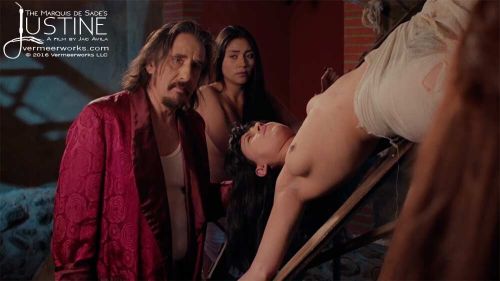by Rich Moreland, December 2016
SPOILER ALERT! The ending of Justine is revealed in the final installment of this five-part review.
Writing about the Broadway blockbuster “Hamilton,” the Huffington Post’s Catherine Rappell said, “Art should be political (as this brilliant show already is, in spades). Artists should be political, too.”
Consider her words as we further our look at Justine.
All photos are courtesy of Pachamama Films/ Decadent Cinema.
* * *
 Within the pages of Justine, the Marquis de Sade rails against the Church and the worthlessness of virtue.
Within the pages of Justine, the Marquis de Sade rails against the Church and the worthlessness of virtue.
A self-proclaimed atheist, Sade writes of a vice-ridden world that takes what it wants and offers no quarter.
In his film version of Justine, Jac Avila explores Sade’s idea through one of the Marquis’s characters, Rodin the Scientist, who assumes a God-like role in the name of science . . . appropriate because the story takes place in the Age of Enlightenment.
This updated Rodin is not an atheist in true Sadean fashion, but he is a libertine, a political philosophy that also came to mean sexually obscene in Sade’s time.
And there’s one more difference. Rodin gives his victims a taste for vice that goes beyond Sade, empowering the feminine to criticize and inflict pain, if only so briefly.
Friday Punishments
Following the slave auction, Justine finds herself in Rodin’s home. His attentions make her uncomfortable.
“What need has he for a third woman, I asked myself? Why must they all be so pretty?” she says, again breaking the fourth wall.
Taking Justine to a secret panel in her bedchamber, Rosalie pulls back a curtain to reveal the dungeon where Rodin conducts his Friday punishments.
Her father comes up with “trifles” to justify his pleasures, Rosalie explains.
Today, it is Omphale. As Justine watches, she turns to the viewer. “For libertinage alone,” she declares, “the passions he carries to its extremes.”
Denouncing her father as a monster, Rosalie says he has “a grand plan divine” for her and it is not pleasant.
“Poor Rosalie is doomed.” Justine pronounces with resignation.
Truth and Perfection
The film now moves into the dungeon for an extended display of Rodin’s sadism. S&M lovers will sit up and take notice.
After finishing with Omphale, the scientist puts Rosalie on the rack in a crucifixion position that presages what it to come. He explains to Justine, the now unwilling third victim in this Biblical farce, his libertine philosophy.
“I seek truth, I seek perfection,” and that can only be done by offering “the cruel death of our firstborn.”
In a parody of the Church, Rodin will be God, his Christ a female.
In other words, Jac Avila challenges Sade with a contradiction that is political to the core.
Rodin is a usurper, a pedophile, an incestuous sadist who dances in the forest with the devil. Yet he recognizes what Swiss psychologist Carl Jung asserts is the duality of man.
Jung asserts that the definition of God (Good) is silent without its opposite, evil, which gives “good” its meaning. Likewise, virtue can only be understood through examining vice.
What’s more, Rodin is raising the earthly female to equal Christ, creating his own collective of tortured martyrs and flings it in the face of the Church. Christ only has meaning through the existence of woman.
In an ironic twist, it is a feminist statement that decries the Medieval Church’s patriarchal attitudes on one hand while revealing the Christian disdain for the sexually open “fairer sex” on the other.
He Shall Rule Over You
Rodin passes the whip to Justine.
 Looking into the camera, Justine reminds us that God curses and punishes Eve “because she has eaten from the tree of knowledge.”
Looking into the camera, Justine reminds us that God curses and punishes Eve “because she has eaten from the tree of knowledge.”
Justine the virtuous suddenly becomes Justine the enforcer, inflicting agony under the cover of religion in a victory for vice . . . at least momentarily.
Forcefully striking Rosalie, Justine again directs her attention to the camera’s eye.
“Intense,” she declares with conviction and lands another blow on the bloodied girl. “And prolonged pain (another strike) meted out as punishment (another crack on the suffering Rosalie) appears almost immediately in the pages of the Bible.”
Omphale now takes the flogger as Rodin lays Justine on the floor and penetrates and debases her simply because he can. Feminism is empowered, then violated.
Justine hurls a political invective at God about the pain of childbirth.
Rodin pumps away; her anger builds.
Speaking directly to women, Justine continues with dripping sarcasm.
“Yet your desire shall be for your husband and he shall rule over you.”
This is feminism in its most dramatic moment, a belligerent and contemptuous rejection of a male hegemony born of the faith.
This is not Sade’s Justine, not even close.
It’s a superb piece of filmmaking.
From Victim to Participant
After her rape, Justine is the next object of Rodin’s amusement. Put on the rack, she is pulled taut, screams, and is released for another go in a repeated chorus of revenge, martyrdom, and sexual brutality.
Later in the bedroom, Justine and Rosalie spread Omphale’s arms restraining her as she is having sex with Rodin. Justine whips the girl while she “enjoys” a ride of pain and pleasure.
At this moment, Justine is not a victim, she is in control, a libertine-in-waiting who metes out ecstasy with every stroke.
Is this virtue’s revenge, or virtue merely on hold?
And, what is the larger question?
Perhaps it is that virtue and vice are interchangeable and no one can be distinctly one or the other despite Sade’s best efforts to prove otherwise.
Nothing Better?
Returning to the dungeon, Rodin takes up Sade’s argument on eternity, but gives it a perverse spiritual touch.
Referencing his intentions with Rosalie, he says to Justine, “If nothing is lost to Nature, if nothing perishes . . . if a decomposed body just awaits dissolution merely to return in another form, then this act of cruelty and murder is indifferent.”
Justine slowly and deliberately claps her hands in mockery and disgust.
“I applaud you, our dear lord and master. Your wisdom astonishes me, but your indifference confounds me. I thought you amorous.”
Feminism strikes again and Justine parlays it into a brief, commendable moment.
But wait, is she really addressing the supposedly loving God whose motivations are pure guesswork?
Rodin’s replies he tortures when he has “nothing better to do.”
Are his words a tribute to the Old Testament God who reigns misery on mankind seemingly without purpose and a reference to Sade’s monks who in the end dispatch their victims without rhyme or reason?
With that, Rodin furthers his entertainment and puts Omphale on the rack.
Obviously, Rosalie’s decomposing body is destined not be alone.
The Wheel
A motif of the extended torture scenes is the wheel in Rodin’s dungeon. He puts each girl on it in turn.
The device is a nod to the Inquisition, the stock-in-trade of the Medieval Church. The wheel secured its victims for, among other things, a good flogging. To the delight of the perverse inquisitors, whipping was the pretext for exposing female flesh in the name of redemption.
Incidentally, Rodin’s wheel only turns in one direction, left to right. When one girl is punished, the others rotate the wheel, in effect taking the scene back in time when the Church’s word was unassailable.
Oh yes, the wheel also shows us that throughout the ages women are the submissives in a never-ending cycle (circle?) of male dominance.
When this scene winds down, Rodin gets a bottle of beer and pauses to admire his work . . . a tribute to sadomasochism turned into art!
Rosalie is on the wheel, Omphale on the rack (which has its own wheel for increasing the pain, incidentally), and the raped Justine chained to the wall with a metal collar and heavy ball pressuring on her neck.
Beauty has no limits.
The next post will look at the imagery Jac Avila employs to enliven his narrative.
* * *
No matter whose film it is, Amy and Jac are always working together for the best outcome . . .
And sometimes more discussion to get things just right evolves into a group effort . . .
















Pingback: Yo Solo Veo Oscuridad: Justine de Jac Avila, Parte Tres – Pachamama Films